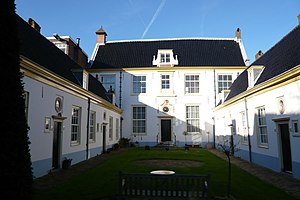Vrouwe- en Antonie Gasthuys
). The other one was for both women and men called the St. Anthoniegasthuys, founded on July 1 (O.L. Vrouwen visitatie) by Jan Claes Dierdtssen under the management of the brothers of St. Anthony (also referred to as the "Heilige Kruisgilde" or Holy Cross guild) on the Hagestraat. These two Gasthuysen operated independently as common "shelters for christians" until after the Protestant Reformation, when all church property reverted to the Haarlem city council in 1581. The two foundations then split off from their church-related management and continued to operate as hofjes independently of each other until they were finally merged as one foundation in 1726.|thumb]]
Vrouwe- en Antonie Gasthuys was a historical institution that played a significant role in the healthcare and social welfare landscape of its time. The establishment of such gasthuys (a term that can be translated to "guest house" or "hospital" in contemporary English) was a common practice in the Middle Ages and early modern period, serving as a precursor to modern hospitals and social services.
History[edit | edit source]
The Vrouwe- en Antonie Gasthuys originated in an era when the care for the sick, poor, and elderly was primarily a charitable activity, often undertaken by religious organizations. These institutions were vital in providing care and shelter to those in need, at a time when state-provided social and healthcare services were non-existent.
Function and Services[edit | edit source]
The primary function of the Vrouwe- en Antonie Gasthuys was to offer healthcare and shelter to the less fortunate. This included not only the sick but also the poor, travelers, and the elderly who had no one else to care for them. The services provided by such institutions were crucial in an age when medical knowledge was limited and social safety nets were rare.
Architecture and Location[edit | edit source]
Typically, gasthuys like the Vrouwe- en Antonie were significant architectural features in their communities. They were often located near the center of towns or cities, close to churches or other religious establishments. The architecture of these buildings was designed not only for functionality but also to convey a sense of sanctuary and peace.
Legacy[edit | edit source]
The legacy of the Vrouwe- en Antonie Gasthuys, and similar institutions, is seen in the evolution of the modern healthcare system and social services. They represent an early form of what would eventually become hospitals, nursing homes, and social welfare organizations. The concept of providing care and shelter to those in need, regardless of their ability to pay, is a principle that continues to underpin many aspects of modern society.
See Also[edit | edit source]
Search WikiMD
Ad.Tired of being Overweight? Try W8MD's physician weight loss program.
Semaglutide (Ozempic / Wegovy and Tirzepatide (Mounjaro / Zepbound) available.
Advertise on WikiMD
|
WikiMD's Wellness Encyclopedia |
| Let Food Be Thy Medicine Medicine Thy Food - Hippocrates |
Translate this page: - East Asian
中文,
日本,
한국어,
South Asian
हिन्दी,
தமிழ்,
తెలుగు,
Urdu,
ಕನ್ನಡ,
Southeast Asian
Indonesian,
Vietnamese,
Thai,
မြန်မာဘာသာ,
বাংলা
European
español,
Deutsch,
français,
Greek,
português do Brasil,
polski,
română,
русский,
Nederlands,
norsk,
svenska,
suomi,
Italian
Middle Eastern & African
عربى,
Turkish,
Persian,
Hebrew,
Afrikaans,
isiZulu,
Kiswahili,
Other
Bulgarian,
Hungarian,
Czech,
Swedish,
മലയാളം,
मराठी,
ਪੰਜਾਬੀ,
ગુજરાતી,
Portuguese,
Ukrainian
Medical Disclaimer: WikiMD is not a substitute for professional medical advice. The information on WikiMD is provided as an information resource only, may be incorrect, outdated or misleading, and is not to be used or relied on for any diagnostic or treatment purposes. Please consult your health care provider before making any healthcare decisions or for guidance about a specific medical condition. WikiMD expressly disclaims responsibility, and shall have no liability, for any damages, loss, injury, or liability whatsoever suffered as a result of your reliance on the information contained in this site. By visiting this site you agree to the foregoing terms and conditions, which may from time to time be changed or supplemented by WikiMD. If you do not agree to the foregoing terms and conditions, you should not enter or use this site. See full disclaimer.
Credits:Most images are courtesy of Wikimedia commons, and templates Wikipedia, licensed under CC BY SA or similar.
Contributors: Prab R. Tumpati, MD


